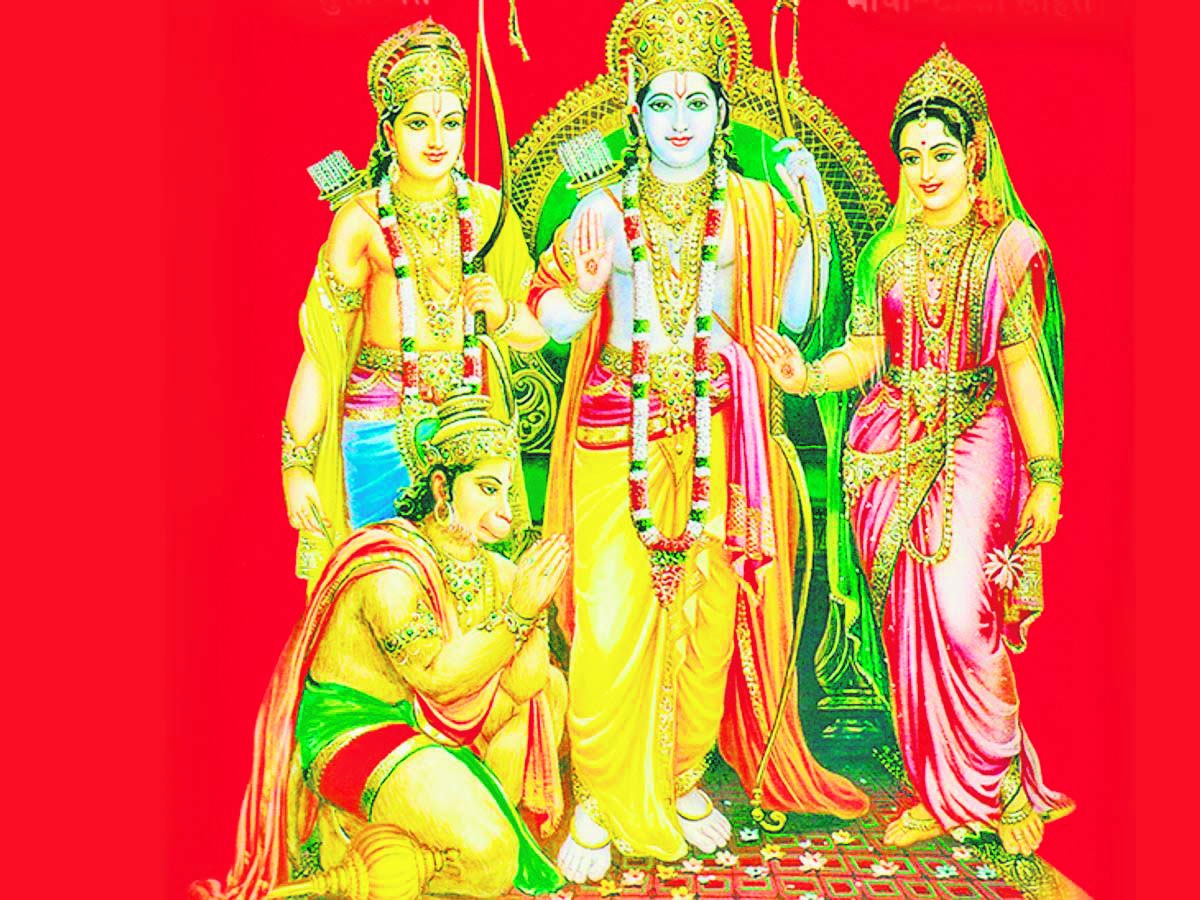
The amazing history and intellectual heritage of Bharat is reflected in the Ramayana. Fundamentally, the Ramayana is a story of morality, love, duty, and dharma (righteousness), entwined with a complex web of people, happenings, and lessons that have inspired millions of people throughout history.
The journey of Lord Rama has been depicted by many scholars and today, we will dive into more details of the same:
Valmiki’s
Ramayana
In Hindu literature, Valmiki’s “Ramayana” is considered a great and highly esteemed epic. The “Mahabharata” is the other of the two great Sanskrit epics of ancient Indian history. It is commonly credited to the sage Valmiki, a contemporary of Lord Rama.
With 24,000 verses divided into seven cantos (kāṇḍas), the “Ramayana” narrates the tale of Rama, a divinity Vishnu’s avatar. The story revolves around the exile of Rama from his kingdom, the kidnapping of his wife Sita by the demon king Ravana, and her ultimate recovery, aided by Hanuman, the powerful monkey deity, and his obedient brother Lakshmana, among others.
Hindu philosophy holds that there are four main goals for human life: dharma (duty/righteousness), artha (prosperity), kama (desire), and moksha (liberation). Each portion of the “Ramayana” highlights a different facet of these goals. The text has a significant impact on Indian life and culture and is regarded as a moral manual that teaches people how to behave morally as a king, wife, son, brother, and disciple, among other roles.
Tulsidas’ Ramcharitmanas: The Awadhi Rendition
The 16th-century “Ramcharitmanas” by Tulsidas is a widely regarded version of the Ramayana. While Tulsidas authored “Ramcharitmanas” in the Hindi dialect of Awadhi, Valmiki wrote “Ramayana” in Sanskrit. Since professors and priests were the main readers of Sanskrit at the time, this decision made the epic more understandable to the general public.
The translation of “Ramcharitmanas” is “Lake of the Deeds of Rama.” This narrative was written by Tulsidas as a poem consisting of seven kāṇḍas, or volumes, that resemble the format of Valmiki’s “Ramayana”. Balakanda, Ayodhyakanda, Aranyakanda, Kishkindhakanda, Sundarakanda, Lankakanda, and Uttarakanda are the names of these kāṇḍas.
Despite being a recounting of Lord Rama’s tale, “Ramcharitmanas” stands out for emphasizing bhakti (devotion). Tulsidas added spiritual themes to the story, showing Rama as a metaphor of individual devotion to God as well as an expression of heavenly grace. The Bhakti movement, which at the time was quite popular in North India, is strongly ingrained in the work.
“Ramcharitmanas” is highly regarded for both its literary value and spiritual profundity. Doha and Chaupai are the two most noticeable of the several meters (chhandas) that Tulsidas used in the composition. The book is a significant lyrical work since it is full of allegories, metaphors, and similes.
In numerous regions of India, particularly those that speak Hindi, “Ramcharitmanas” is not only a sacred text but also an integral element of the people’s culture and spirituality. Its lines are committedly remembered and sung, and it is frequently chanted in temples and homes. The impact of “Ramcharitmanas” on the Indian psyche and its contribution to the devotion to Lord Rama is great, making it a cornerstone of Hindu literature and spirituality.
Kamban’s Ramavataram: The Tamil Interpretation
Composed in the 12th century, Kamban’s “Ramavataram,” also known as “Kamba Ramayanam,” is a well-known Tamil adaptation of the Ramayana. Considered a masterpiece of Tamil literature, it is as highly esteemed among Tamil-speaking Hindus as Tulsidas’ “Ramcharitmanas” is in Hindi-speaking areas.
The Ramayana as adapted by Kamban is renowned for its literary depth and stylistic and emphasisal divergence from Valmiki’s original Sanskrit translation. Although the primary plot stays true to Valmiki’s tale, Kamban adds local and cultural aspects specific to Tamil culture in addition to his own imaginative ideas, creating a version that strongly appeals to the Tamil audience.
The Uttara Kanda included in Valmiki’s version of the “Ramavataram” is absent from the six kandams (books) that comprise the work. These kandams are called Yuddha Kandam, Kishkindha Kandam, Sundara Kandam, Ayodhya Kandam, Aranya Kandam, and Bala Kandam. Kamban’s use of the Tamil language is praised for its eloquence, rich imagery, and profound emotional appeal. His lyrical style is quite advanced.
Kamban’s rendering of the characters, particularly Rama, demonstrates a unique style. He emphasizes Rama’s moral attributes and virtues. The epic is made more accessible to the audience by this humanistic interpretation, which also highlights the moral and emotional aspects of the narrative more fully.
Buddhist Ramayana: Dasharatha Jataka
“Dasharatha Jataka” is a distinctive and important Buddhist interpretation of the Ramayana tale. It is a section of the Jataka stories, an extensive corpus of Buddhist writing about Gautama Buddha’s prior human and animal incarnations. In the “Dasharatha Jataka,” the Buddhist narrative of Rama is reinterpreted.
This passage, called the “Dasaratha-Jātaka” (Jataka No. 461) in Pali, depicts the story as one of the Buddha’s past lives. Here, Rama is shown as a Bodhisattva, a human on the way to becoming a Buddha. The story is very different from the conventional Hindu interpretations of the Ramayana, as related by Kamban, Tulsidas, or Valmiki.
Jain Ramayana: Paumacariyam
The Ramayana in Jain is called the “Paumacariyam” (often written “Pauma Chariu” or “Padma Charita”). It is a special Ramayana narrative. Written in Prakrit, this work by Vimalasuri presents a unique reading of the Ramayana that is consistent with Jain principles and beliefs.
In addition to being a religious text, the “Paumacariyam” is an important piece of Jain literature that captures the religious and cultural context of the Jain community. Similar to other renditions of the Ramayana, it has impacted Jain religious ideas, art, and culture. The book serves as an example of how the Ramayana, a fundamental tale, has been modified and reinterpreted in a number of Indian religious traditions, each of which reflects the particular moral and intellectual code of that tradition.
Sidhharrth S Kumaar, Chief Happiness Officer at NumroVani, is an Astro Numerologist and life and relationship Coach on a mission to transform human lives by curating synergy between human aura and cosmic universe by leveraging traditional intellectual
knowledge of Bharat.















